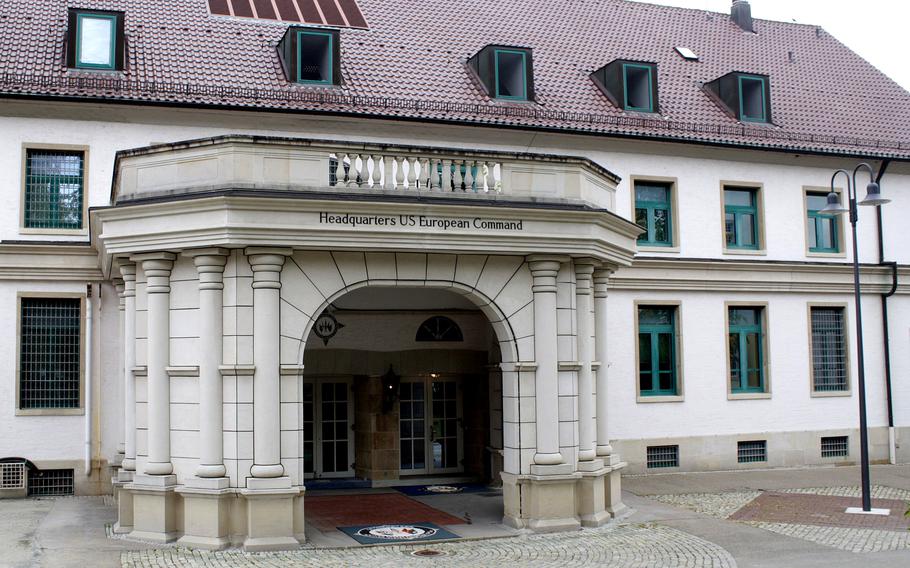
The 90-year-old U.S. European Command headquarters building at Patch Barracks in Stuttgart, Germany. Antiquated systems and outdated facilities are among the challenges ahead as the command seeks to modernize for warfare that requires making quick sense of mountains of data. (John Vandiver/Stars and Stripes)
STUTTGART, Germany — At U.S. European Command’s headquarters, housed in a 90-year-old building that once served as a mess hall for Nazi troops, commanders still rely partially on analog tools to process information.
A combination of antiquated systems and outdated facilities is one of the foremost challenges for the command as it prepares for a future in which battlefield success will hinge on making quick sense of mountains of data, military officials say.
This month, military leaders from across Europe were in Stuttgart for a three-day summit at EUCOM headquarters learning about ways to build more effective command and control structures. While commanders didn’t specify in detail the technical nature of EUCOM’s shortcomings, old manual processes are still a feature of the system, officials said.
“There’s proliferation of a lot of technology right now,” Maj. Gen. Pete Andrysiak, EUCOM’s chief of staff, said Wednesday. “And while it’s available to us, it’s also available to our adversary.”
The task centers on stitching together systems to combine information from an array of places and convert it into digestible chunks for top leaders such as Gen. Christopher Cavoli, NATO’s supreme allied commander.
EUCOM finds itself playing catch-up with other major headquarters, such as the Central and Indo-Pacific commands. After the Cold War and during two decades of counterinsurgency fighting, EUCOM was low on the list of Pentagon priorities.
The command’s focus went from countering the Soviet army to softer security cooperation activities on a Continent where fears of large-scale conflict were viewed as a relic from a bygone era.
Russia’s invasions of Ukraine in 2014 and 2022 changed old assumptions about a secure Europe and set EUCOM on a course to rebuild its headquarters into one capable of commanding troops at war.
“There was no requirement for war fighting capabilities, so we divested those,” Andrysiak said. “We focused on a different mission. So now we come full-circle.”
Bringing EUCOM to a state of preparedness for the future of warfare means integrating artificial intelligence and leveraging real-time data so decisions can be made more quickly, Andrysiak said
Obstacles stand in the way, however. When it comes to funding command and control set-ups, most of the money is directed toward the military’s service branches.
While combatant commanders oversee those forces in a war scenario, organizations like EUCOM get only a small piece of the funding pie.
Similar funding shortfalls contribute to a brick-and-mortar issue for EUCOM, given how old its headquarters building is.
The cost to build a modern EUCOM hub in line with those of other combatant commands stands at about $500 million, a requirement unlikely to ever be funded, Andrysiak wrote in a Dec. 10 essay for the military journal War on the Rocks.
Other Army infrastructure projects such as improving soldier barracks get priority over a new headquarters, which means EUCOM hasn’t gotten the needed reinvestment over time, he said.
“So we’ve got to work with what we have,” said Andrysiak, who added that the process for allocating resources should be reformed.
Besides funding issues, military officials also said policies need to be updated to ensure that information can be shared quickly across the NATO alliance.
Brig. Gen. Andrew Saslav, U.S. Army Europe and Africa deputy chief of staff for operations, said military policy is too slow to adapt to the pace of technological advances.
For example, the Army is able to aggregate unclassified maintenance data for systems used by its soldiers so commanders can have a clear picture of requirements under one “super system” source.
But “policy habits” make it so that pulling together the data turns the information classified, limiting what Army leaders can share with allies, Saslav said.
In a crisis, “if my boss can’t share that information seamlessly across the alliance, then the information is largely useless,” Saslav said.